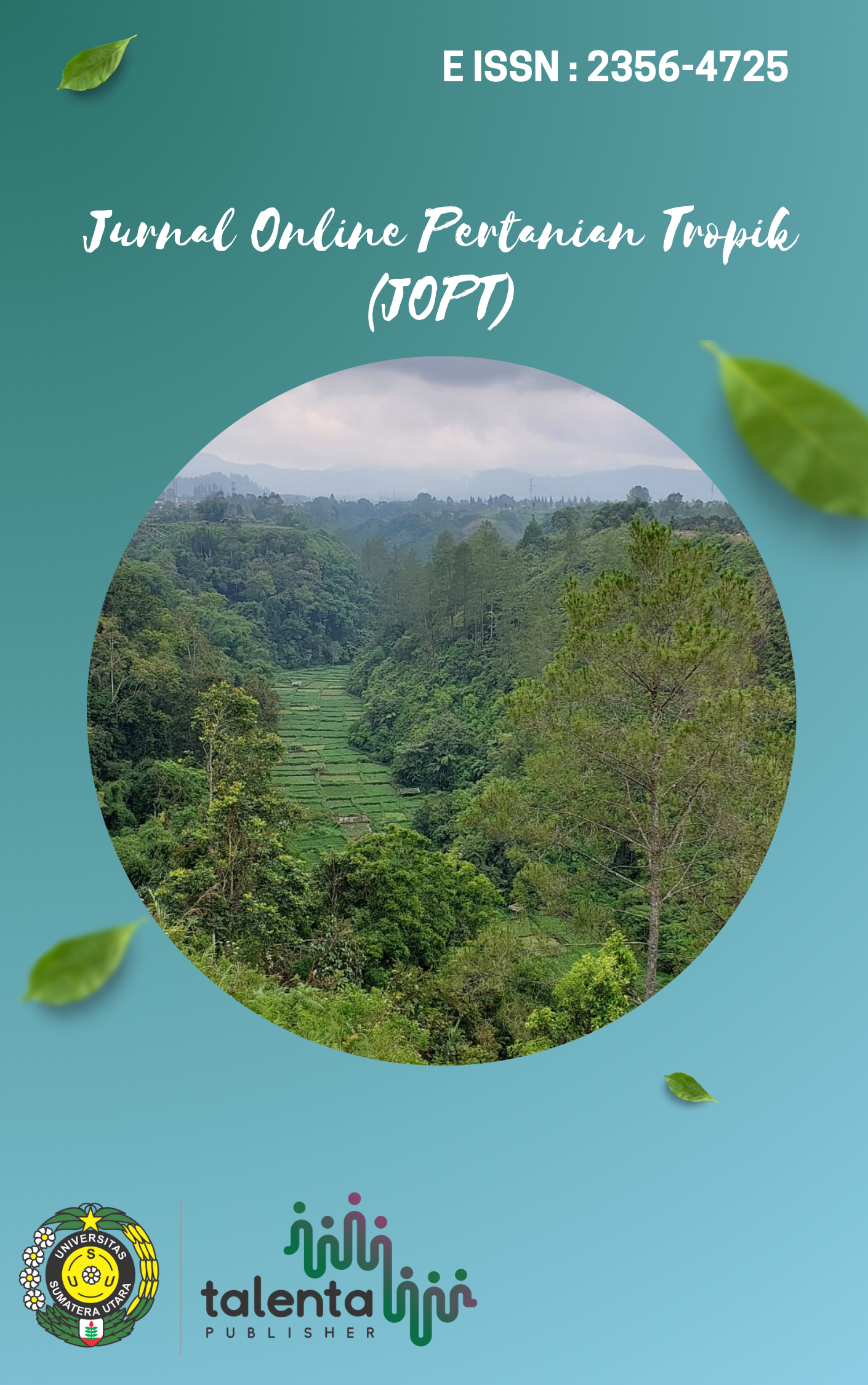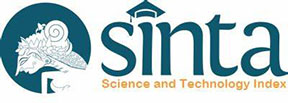Usage of Jatropha curcas as Botanical Insecticide in Controlling Insect Pest
DOI:
https://doi.org/10.32734/jopt.v10i1.14032Keywords:
Jatropha curcas, Botanical insecticide, Insect pestAbstract
Insect pests can cause damage to plants and cause losses. Insect pests on plants need to be controlled both preventively and curatively. Integrated control is an integration of several control methods that can be implemented in a compatible and comprehensive. Insect pest control using bio-active plant materials as an alternative to synthetic chemicals. Plants produce secondary metabolite compounds that can affect insects, including Jatropha curcas (Euphorbiaceae). Studies on several insect pests both in the laboratory and in the field against insect pests that attack the field and agricultural product storage warehouses have been carried out to determine their effectiveness. Jatropha curcas plants/parts of plant were applied after extraction treatment with various solvents (water, ethanol, methanol, acetone, petroleum ether, n-hexane and chloroform) or direct use. The results showed that J. curcas exhibited control effects against several types of insect pests from various insect pest. Laboratory study showed the insecticidal effect of J. curcas against Helicoverpa armigera, Spodoptera frugiperda, Plutella xylostella, Earias insulata, Spilarctia oblicua, Tuta absulata, Nezara viridula, Corcyra cephalonica, Maruca vitrata. Field study showed population reduction of Putella xylostella and Aphis craccivora. Whilst, on stored product study showed mortality of insect pest (Sitophilus zeamais, Rhyzopertha dominica, Callosobruchus chinensis and C. maculatus) and reduction of weight loss of stored products. Jatropha curcas has the potential as a pest insect control to be integrated into the IPM component.
Keywords: Jatropha curcas, Botanical insecticide, Insect pest
Downloads
References
Adebowale, K.O., C.O. Adedire. 2006. Chemical composition and insecticidal properties of the underutilized Jatropha curcas seed oil. Afr. J. Biotechnol. 5, 901–906.
Amoabeng, B.M., G.M. Gurr, G.M., Gitau, C.W., Nicol., H.I., Munyazaki, L., Stevenson, P.C. 2013. Tri-tropic insecticidal effects of African plants against cabbage pests. Plos ONE.
Asmanizar, A. Djamin, A.B. Idris. 2012a. Evaluation of Jatropha curcas and Annona muricata seed crude extracts against Sitophilus zeamais infesting stored rice. Journal of Entomology 9(1):13-22.
Asmanizar, A. Djamin, A. B. Idris. 2012b. Effect of four selected plant powder as Rice Grain Protectant. Sains Malaysiana. 41(7): 863–869.
Asmanizar, Aldywaridha, E. Sumantri, R.M. Lubis, D. Siregar, F. Maimunah. 2019. Evaluation of potential plant crude extracts against green stink bug Nezara viridula Linn. (Hemiptera: Pentatomidae). Serangga 24(2):15-24.
Asmanizar, Aldywaridha, E. Sumantri, R.M. Lubis. 2020. Respons Nezara viridula (Hemiptera: Pentatomidae) terhadap beberapa ekstrak kasar tanaman. Vegetalika 9(2): 414-424.
Babarinde, G.O., S.A. Babarinde, T.K. Ojediran, A.F. Odewole, D.A. Odetunde, T.S. Bamido. 2019. Chemical composition and toxicity of Jatropha curcas seed oil against Sitophilus zeamais Motschulsky as affected by pre-extraction treatment of seeds. Biocatal. Agric. Biotechnol. 21, 101333.
Cook, S.M., Z.R. Khan, J.A. Pickett. 2007. The use of push-pull strategies in integrated pest management. Annual Review of Entomology 52:375–400.
de Oliveira, H., A. Santana, M. Antigo. 2013. Insecticide activity of physic nut (Jatropha curcas L.) oil and neem (Azadirachta indica A.Juss.) oil on eggs of Diatraea saccharalis (Fabr.)(Lepidoptera: Crambidae). Arq. Do Inst. Biol. 80, 229–232.
Devappa, R.K., H.P.S. Makkar, K. Becker. 2011. Jatropha diterpenes: A review. J. Am. Oil Chem. Soc. 88, 301–322.
Devappa, R.K., M.A. Angulo-Escalante, H.P.S. Makkar, K. Becker. 2012. Potential of using phorbol esters as an insecticide against Spodoptera frugiperda. Ind. Crops Prod. 38, 50–53.
Dodia, D.A., I.S. Patel, G.M. Patel. 2008. Botanical Pesticides for Pest Management. Jodhpur: Pawan Kumar Scientific Pub.
Gübitz, G., M. Mittelbach, M. Trabi. 1999. Exploitation of the tropical oil seed plant Jatropha curcas L. Bioresource Technology, 67(1), 73-82.
Habib-ur-Rehman, Mansoor-ul-Hasan, Q. Ali, M. Yasir, S. Saleem, S. Mirza, H. Shakir, A. Alvi, H. Ahmed, H. 2018. Potential of three indigenous plants extracts for the control of Tribolium castaneum (Herbst) and Rhyzopertha dominica (Fab.). Pak. Entomol. 40, 31–37.
Habou, Z.A., A. Haougui, G. Mergeai, E. Haubruge, A. Toudou, F.J. Verheggen. 2011. Insecticidal effect of Jatropha curcas oil on the aphid Aphis fabae (Hemiptera: Aphididae) and on the main insect pests associated with cowpeas in Niger. Tropicultura:29, 225–229.
Harimurti, N., dan D. Sumangat. 2011. Pengolahan biji jarak pagar (Jatropha curcas L.) menjadi sumber bahan bakar nabati dan pemanfaatan produk samping. Buletin Teknologi Pascapanen Pertanian 7 (1): 48- 55.
Holtz, A.M., J.S. Marinho-Prado, T.P. Cofler, A.B.M. Piffer, M.d.S. Gomes, V. Borghi Neto. 2021. Insecticidal potential of physic nut fruits of different stages of maturation on Myzus persicae (Hemiptera: Aphididae). Idesia. 39, 93–99.
Ingle, K.P., A.G. Deshmukh, D.A. Padole, M.S. Dudhare, 2017. Screening of insecticidal activity of Jatropha curcas (L.) against diamond back moth and Helicoverpa Armigera. Journal of Entomology and Zoology Studies, 5(1):44-50.
Ishag, A., S.E.M. Osman. 2020. The Ovicidal Effect of Jatropha (Jatropha curcas) and Argel (Solenostemma argel) on Eggs of the Spiny Bollworm Earias insulana (Lepidoptera: Noctuidae)]. Int. J. Sci. Res. Eng. Dev. 3, 7.
Isman, M.B. 2006. Botanical insecticide, deterrent and repellent in modern agriculture and increasingly regulated world. Annual Review of Entomology 51:45-66.
Jide-Ojo, C. 2013. Extracts of Jatropha curcas L. exhibit significant insecticidal and grain protectant effects against maize weevil, Sitophilus zeamais (Coleoptera: Curculionidae). J. Stored Prod. Postharvest Res. 4, 44–50.
Khani, M., R.M. Awang, D. Omar, M. Rahmani. 2013. Toxicity, antifeedant, egg hatchability and adult emergence effect of Piper nigrum L. and Jatropha curcas L. extracts against rice moth, Corcyra cephalonica (Stainton). J. Med. Plants Res. 7, 1255–1262.
Kona, N.E.M., A.K. Taha, M.E. Mahmoud. 2014. Effects of botanical extracts of Neem (Azadirachta indica) and jatropha (Jatropha curcas) on eggs and larvae of tomato leaf miner, Tuta absoluta (Meyrick) (Lepidoptera: Gelechiidae). Persian Gulf Crop Prot. 3, 41–46.
Kumar, A., S. Sharma. 2008. An evaluation of multipurpose oil seed crop for industrial uses (Jatropha curcas L.): a review. Ind Crops Prod., 28, 1-10.
Kumar, V., S. Singh, A. Shukla, J. Chaudhary. 2014. Evaluation of subacute toxicity of Jatropha curcas seeds and seed oil toxicity in rats. Indian J. 38, 88–93.
Makkar, H.P.S., K. Becker, F. Sporer, M. Wink. 1997. Studies on nutritive potential and toxic constituents of different provenances of Jatropha curcas. J. Agric. Food Chem. 45, 3152–3157.
Muniz, D., I. Zaidan, L.d.S. Dias, J. Leite, J. Diniz. 2020. Biocide potential of Jatropha curcas L. extracts. J. Biol. Life Sci. 11, 138–154.
Mwine, J., C. Sekyewa, K. Kalanzi, P. Van Damme. 2013. Evaluation of selected pesticidal plant extracts against major cabbage insect pests in the field. J. Med. Plants Res. 7, 1580–1586.
Opuba, S.K., A.D. Adetimehin, B.N. Iloba, O.O. Uyi. 2018. Insecticidal and anti-ovipositional activities of the leaf powder of Jatropha curcas (L.) (Euphorbiaceae) against Callosobruchus maculatus (F Coleoptera: Chrysomelidae). Anim. Res. Int. 2018, 15, 2971–2978.
Poppy, G.M., P.C. Jepson, J.A. Pickett, M.A. Birkett. 2014. Achieving food and environmental security: new approaches to close the gap. Phil. Trans. R. Soc. B, 369: 20120272.
Septyadi, M.C., R.A. Nurbaini, Farid. 2007. Mengenal Tanaman Jarak Pagar (Jatropha curcas L.). BPTP Kalimantan Timur. Lembar Informasi Pertanian. Departemen Pertanian. https://repository.pertanian.go.id. Diakses pada tanggal 20 Juli 2022.
Sharma, K. 2012. Effect of leaf extract of Jatropha curcas on growth and development of Bihar hairy caterpillar, Spilarctia obliqua, Walker. Int. J. Plant Prot. 5, 183–184.
Sherchan, D.P., Y.B. Thapa, J.T. Khadka, T.P. Tiwari. 1989. Effect of green manure on rice production. Pakhribas Agriculture 2, 12-15.
Silva, G.N., L.R.A. Faroni, A.H. Sousa, R.S. Freitas. 2012. Bioactivity of Jatropha curcas L. to insect pests of stored products. J. Stored Prod. Res. 48, 111–113.
Soetopo, D. 2007. Potensi jarak pagar (Jatropha curcas L.) sebagai bahan pestisida nabati. Prosiding Lokakarya Nasional Jarak Pagar III. Puslitbangbun, 9-10 Maret 2007. Departemen Proteksi Tanaman. Institut Pertanian Bogor, Bogor.
Supriadi. 2001. Tumbuhan Obat Indonesia: Penggunaan Dan Khasiatnya. Jakarta. Yayasan Obor Indonesia: xi-xxvii. Jakarta
Tudi, M., H. Daniel Ruan, L. Wang, J. Lyu, R. Sadler, D. Connell, C. Chu, D.T. Phung. 2021. Agriculture development, pesticide application and its impact on the environment. Int. J. Environ. Res. Public Health, 18, 1112.
Tukimin, D. Soetopo, dan E. Karmawati. 2010. Pengaruh minyak jarak pagar (Jatropha curcas L.) terhadap mortalitas, berat pupa, dan penularan hama jarak kepyar. Jurnal Littri 16(4): 159-164.
Tukimin, S.W., E. Karmawati. 2012. Pengaruh minyak bungkil biji jarak pagar terhadap mortalitas dan peneluran Helicoverpa armigera Hũbner. Jurnal Littri Vol. 18, (2): 54–59.
Uche, F.I., J.S. Aprioku. 2008. The phytochemical constituents, analgesic and anti-inflammatory effects of methanol extract of Jatropha curcas leaves in mice and Wistar albino rats. J Appl Sci Environ Manage 12:99-102.
Ugwu, J.A. 2020. Insecticidal activity of some botanical extracts against legume flower thrips and legume pod borer on cowpea Vigna unguiculata L. Walp. J. Basic Appl. Zool. 81, 13.
Ugwu, J.A. 2021. Prospects of botanical pesticides in management of Iroko gall bug, Phytolyma fusca (Hemiptera, Psylloidea) under laboratory and field conditions. J. Basic Appl. Zool. 82,24.
Ukpai, O.M., B.N. Ibediungha, C.N. Ehisianya. 2017. Potential of seed dusts of Jatropha curcas L., Thevetia peruviana (Pers.), and Piper guineense Schumach. against the maize weevil, Sitophilus zeamais (Motschulsky, 1855) (Coleoptera: Curculionidae) in storage of corn grain. Pol. J. Entomol. 86, 237–250.
Downloads
Published
How to Cite
Issue
Section
License
Copyright (c) 2023 Jurnal Pertanian Tropik

This work is licensed under a Creative Commons Attribution-ShareAlike 4.0 International License.






















